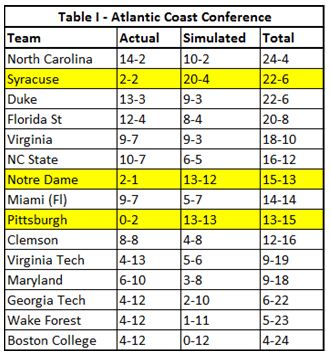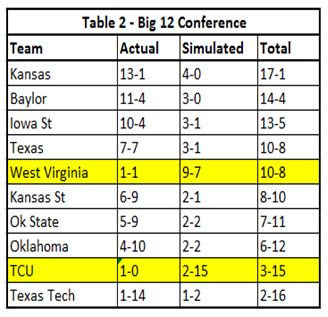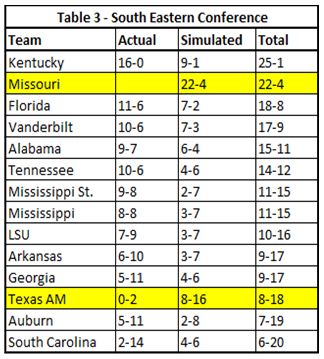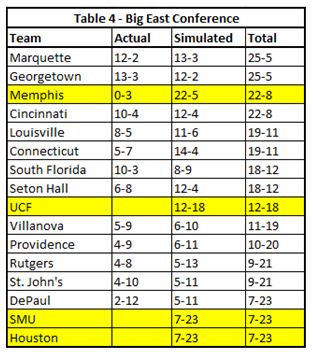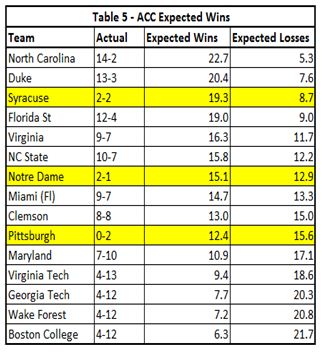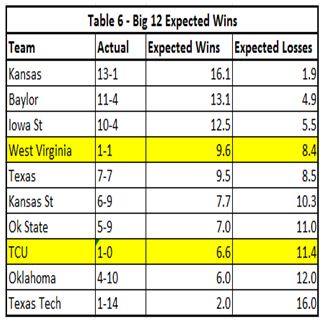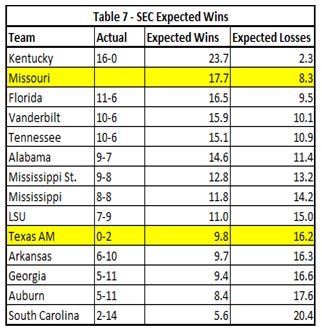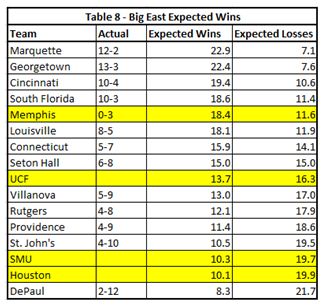By: Zachary Hass and Thomas Nielsen, Purdue University
At every season’s end there is inevitably a conversation about which men’s college basketball conference is the strongest. The “go to” evidence is often centered on how many teams from each conference made the NCAA tournament and how they fared. The emboldened fan will often claim something about how the third place team in their conference would have won any other league or about how poorly some other conference champ would have fared in their stronger conference. While these claims can never really be tested, examining conference realignment can offer a glimpse of how some teams stack up in new conferences.
How will the conference movers perform in their new conferences in 2012? While we wait for the official results, we have used simulations to see how the standings might have looked last year if teams had already switched.
For our experiment we have selected some actual changes, effective for the next season (West Virginia to the Big 12), and some not taking effect for a year or two (Notre Dame, Syracuse and Pitt to the ACC). Additionally, to get a better feel for how the “re-imagined” men’s college basketball standings would shake out, we assumed a double round-robin schedule, meaning each team played all other teams in the conference twice with one home game and one away. The scheduling assumption eliminates any guesswork about how a conference might schedule in new teams, and creates a more equitable basis of comparison. 1 If a game in our simulated schedule was actually played last season, its result is taken as fact, otherwise it was simulated. Simulations were based on a statistical model which estimates each team’s offensive and defensive strength as well as a home field advantage parameter based on last year’s regular season results. For each unplayed matchup (including games like Duke at Virginia to complete the double round robin), 100,000 simulations were run and the team with the greater number of simulated victories was granted the win. Results are given below, in each table, teams new to the conference are highlighted in yellow.
Looking at Table 1 in our realigned 2011-2012 season, adding Notre Dame, Syracuse, and Pittsburgh to the ACC and rounding out the schedule puts Syracuse, the 2011-2012 Big East Champion, as the second place finisher to North Carolina (who was also the actual 2011-2012 ACC champ). Pittsburgh and Notre Dame projects to the middle of the pack in the ACC, after finishing 13th and 3rd out of 16, respectively, in the Big East. The drop by Notre Dame suggests that the upper half of the Big East was much weaker last year than the upper half of the ACC The standings are for the most part unchanged otherwise.
Replacing Texas A&M and Missouri with West Virginia and TCU in the Big 12 yielded the above standings in Table 2. West Virginia went from 8th out of 16 in the Big East to 5th out of 12. TCU projects near the bottom of the conference after finishing with a 7-7 record in the Mountain West, their lone actual victory coming against last place finisher Texas Tech at home. Rounding out the schedule also allowed Texas to climb two spots into a fourth place finish.
In the SEC (Table 3), new additions Missouri and Texas A&M project to finish in about the same positions as they finished in the Big 12. This may suggest that conferences are fairly comparable in terms of basketball strength. Missouri goes from 2nd in the Big 12, to 2nd in the SEC. Texas A&M leaves the Big 12 as the 9th (of 10) place finisher and projects as the 12th (of 14) best team in the SEC.
In the Big East (Table 4) we have added Memphis, UCF, SMU, and Houston to replace Notre Dame, Syracuse, Pittsburgh, and West Virginia. All of these changes were at least rumored, but only West Virginia’s departure is effective for next season—and all four additions are from Conference USA. Memphis, the 2011-2012 conference champion, projects well, finishing 3rd behind Marquette and Georgetown. UCF goes from 3rd (of 12) in Conference USA to 9th (of 16) in the Big East. Both SMU and Houston project to the bottom of the conference.
Although these simulated results are clean to look at, they may not give the best picture of how a team projects. After all, a 51% chance of winning is a whole different animal than a 90% chance of winning. Therefore, in order to more accurately reflect the projected relative strengths of each team, we organize the standings with a modified approach. Instead of awarding a full win for the simulated results, the tables below give expected wins. For instance, if Duke had an 83% chance of defeating Clemson at home, according to the simulations, then Duke would be awarded 0.83 wins and Clemson would receive 0.17 wins. The records no longer make sense (as they include partial wins and losses), but the overall standings are projected more accurately when a 50-50 shot at victory is distinguished from a 90-10 chance.
Looking at expected wins in Table 5 drops Syracuse down one slot to 3rd, Notre Dame holds steady, and Pittsburgh down one to 10th place in the ACC. In the Big 12 (Table 6), West Virginia moves up one spot to 4th, place and TCU moves up one to 8th. In the SEC (Table 7), Missouri holds on to 2nd place, a solid full win ahead of Florida, and Texas A&M moves up two spots to 10th place. In Table 8, Memphis does not fare as well in the Big East, falling to 5th place, while UCF holds steady in 9th. SMU and Houston both move ahead of DePaul for 14th and 15th place, respectively. Overall, the most significant change is that Memphis does not look quite as strong in the Big East as the first method indicated.
So how do conferences stack up when viewed through the lens of teams that have moved? It looks like Syracuse would have been a championship contender in the ACC as would Missouri in the SEC. Memphis and West Virginia were in the mix, but not quite favored in the Big East and Big 12, respectively. Pittsburgh, Notre Dame, and UCF projected in the middle, while Texas A&M, TCU, SMU, and Houston projected to the bottom of the pack in their respective leagues.
Zachary Hass is a graduate of Case Western Reserve University where he played safety for the football team and holds a degree in Statistics and Economics. Currently he is working on a MS of Applied Statistics at Purdue University.
Thomas Nielsen is a graduate of Purdue University where he received a Bachelor’s Degree in Mathematical Statistics and a Master’s Degree in Applied Statistics. He currently works for an analytics company near Chicago.
Key Insights
We ran 100,000 simulations of unplayed matchups in the last year to see how some teams stack up in their new conferences. Our results reveal Syracuse as a championship contender in the ACC and Missouri in the SEC. Memphis and West Virginia faired well, but not as well in the Big East and Big 12, respectively. Pittsburgh, Notre Dame, and UCF rounded out the middle, while Texas A&M, TCU, SMU, and Houston projected to be near the bottom of the pack in their respective leagues.
References:
- Going forward the ACC will continue to play an 18-game conference schedule with the addition of Notre Dame based on a two-partner format. Each year, teams will play every league opponent at least once with the two partners playing home and away annually.
http://www.theacc.com/genrel/100312aae.html ↩


